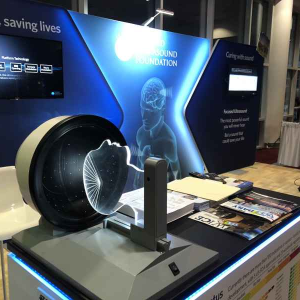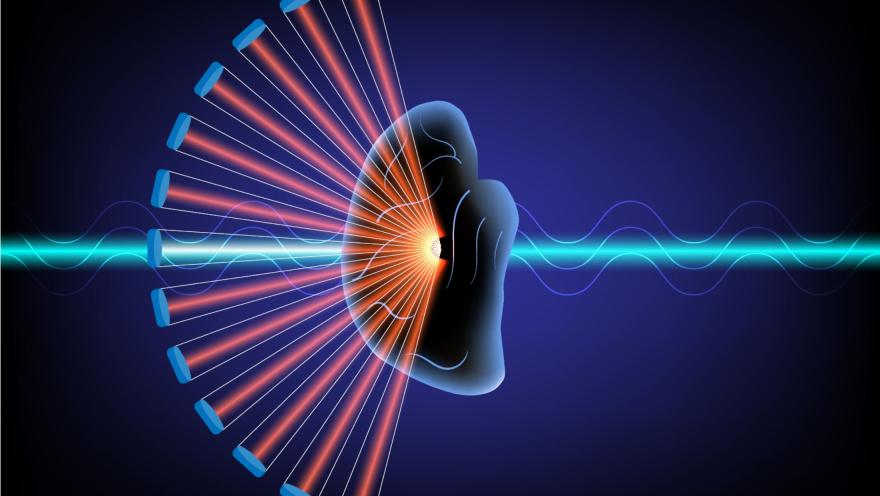It is with heavy hearts we share the news of the recent sudden passing of our colleague and Connecting ALS podcast host, Jeremy Holden. Jeremy was an amazing person, coworker and friend to so many at The ALS Association and will be deeply missed. His contributions to The ALS Association and the families he touched will never be forgotten. This blog focuses on one of the important topics he was planning to share with the community.
For more than 15 years, the Focused Ultrasound Foundation has been dedicated to advancing the development and adoption of focused ultrasound technology. Since its inception, one of the foundation’s priorities has been brain research, including the possible treatment of ALS.
In preparation for a Connecting ALS podcast, Jeremy spoke with Dr. Agessandro Abrahao, a professor of neurology at the University of Toronto and a neurologist at Sunnybrook Health Sciences Center, who spoke about a new partnership between The ALS Association and the Focus Ultrasound Foundation and his work as a focused ultrasound investigator at the Harquail Centre for Neuromodulation.
The following partial transcript of that conversation has been edited for brevity and clarity.
What is focused ultrasound, and how is this technology different from the way we usually think about ultrasounds?

Focused ultrasound is an exciting and novel therapeutic technology that harnesses acoustic sound, acoustic energy to target tissue in deep regions of the body like the brain. And it does that in a non-invasive way, without surgical incisions or radiation. With focused ultrasound, multiple acoustic beams are directed at a single point in the tissue. The principle of focused ultrasound is like holding a magnifying glass and focusing beams of sunlight onto a single point to burn a hole in a leaf. That's different from the standard ultrasound testing that we would think about, which is available everywhere – every hospital, every clinic – and doctors order to diagnose and monitor pregnancies or look at inner organs.
What led you to think or to consider whether focused ultrasound technology could be used for diagnosing or treating ALS?
We know that ALS affects both the lower motor neurons in the brainstem and spinal cord, and also the upper motor neurons leaving the motor cortex of the brain. The pathway towards a cure involves targeting both the lower and upper motor neurons effectively. In fact, there's some research that suggests the dysfunction and degeneration of the upper motor neurons is an early and key driving factor for ALS's progression. It makes sense to target these areas. However, delivering therapeutics to these upper motor neurons remains a big challenge. The reason is that the brain is protected by what we call the blood-brain barrier, or BBB for short.
The blood-brain barrier is important to us because it keeps viruses, bacteria, toxin, bugs that are in the bloodstream, impeding them from getting into the brain. But when we want to deliver therapeutics to the brain, the blood-brain barrier limits the passage of these new and promising therapeutics to the areas of the brain affected by a neurodegenerative disease like ALS.
We hoped to find a technique that could open the blood-brain barrier for a period of time so we could deliver things from the bloodstream to those areas of the brain affected by ALS. And we envisioned that this technique could have three main characteristics.
Number one, the techniques should be non-invasive in contrast to, for example, injecting therapeutics via open surgery to the brain. And that has been tried in patients with ALS in certain clinical trials. So, we thought it should be non-invasive.
Number two, the opening of the blood-brain barrier should be temporary, reversible and repeatable. Then, we could deliver a therapeutic multiple times without compromising the long-term protective effect of the blood-brain barrier. We don't want to disrupt the blood-brain barrier and leave it that way. We still want the protective effects.
Number three, the blood-brain barrier opening should be targeted to the regions of the brain affected by ALS. That would avoid undesired effects in all the regions that are not relevant to ALS and give the therapeutic a more targeted approach.
And here comes focused ultrasound as it checks all the boxes.
We then conducted the world's first trial demonstrating the safe opening of the blood-brain barrier of the motor cortex in four patients with ALS, and this was really exciting. The procedure was well tolerated and reversible in our patients. I'll never forget the first procedure. The patient, who's a truly brave and altruistic individual, felt that cautious optimism and excitement and in the moment said to us, "Guys, let's make history today." This is truly remarkable.
How are the Focused Ultrasound Foundation and The ALS Association working to advance this technology? Where do things stand, and what are some of the next steps?
This partnership will help new research initiatives to further demonstrate the safety of opening the blood-brain barrier over the motor cortex in ALS. It will allow us to test different devices, different strategies, and can potentially also fund and allow research looking at biomarkers that might leak out of the brain into the bloodstream when you open the blood-brain barrier, or the reverse of the primary goal of delivering drugs to the brain.
That creates a unique opportunity. This is the concept of focused ultrasound-enabled liquid biopsy as we know it, whereby markers that are typically trapped in the brain can now be measured in a simple blood sample.
If you think about it, this is an opportunity to introduce a personalized medicine approach to patients with ALS because we know that ALS is a highly heterogeneous disease, especially when it comes to the clinical presentation when it can start in the foot, can start in the arm or in the bulbar region. It can be slowly progressive or can be a fast, rapid disease. It can be associated with frontotemporal dementia. So, it has different clinical shapes, but also when you look internally to the biology of ALS, there's also great variability.
Multiple mechanisms are at play, for example, changes in RNA metabolism or metabolic stress of the mitochondria or neuroinflammation. And that happens in different levels for each individual. So now, focused ultrasound blood-brain barrier opening creates the opportunity to investigate these metabolic, inflammatory or degenerative markers in the bloodstream and could point to specific profiles that could indicate or suggest individualized treatment strategies for a single patient. This could potentially overcome this problem of heterogeneity in ALS.
Looking ahead at the next 5 to 10 years, what's your hope for how this technology could be developed going forward?
We all look forward to a future whereby ALS is a curable disease. After this successful opening of the blood-brain barrier in our first trial in ALS, we think focused ultrasound can help accelerate the therapeutic development in this disease by changing the paradigm of drug delivery to the brain and can also identify these molecular signatures. This could potentially assist in choosing the most promising approach for that specific patient, instead of running trials that follow a one-size-fits-all kind of model where everybody gets in the trial, gets the same dose of that unique drug or placebo, and we see what happens in the end.
In our center, we're almost ready to launch a second trial of focused ultrasound in ALS. This time, we can enroll a larger number of patients, and we're going to open the blood-brain barrier over a larger area of the motor cortex. And for the first time, we're going to combine the open blood-brain barrier with a novel therapeutic. In this case, we're partnering with Clene, and we're going to deliver nanoparticle CNM-Au8. I hope this trial will be launched by the end of the year, and it's been funded by the Focused Ultrasound Foundation and ALS Society of Canada.
And now we're very excited about this recent partnership between The ALS Association and Focused Ultrasound Foundation, which is a remarkable milestone. This will open the opportunity for new research that will accelerate the development of this technology in ALS and will foster further initiatives and funding across the globe that might change the future of ALS. That's what we look forward to.
Applications for Focused Ultrasound and ALS Research Grants are being accepted until October 2. Learn more HERE.
To continue to follow stories from people in the ALS community and learn more about the disease, subscribe to receive our weekly blogs in your inbox HERE or follow us at als.org/blog.


Comments
I have ALS
Tom, so sorry to hear you are living with this disease. Your local ALS Association care team can provide free information, resources and support. Find their contact information at als.org/local-care.
Where can a person with als sign up to participate in the trials?
Hi Debbie, you can find enrolling clinical trials here: https://clinicaltrials.gov/
Are there any focused ultrasound teams/equipment available in Vancouver BC?
Hello Paul. Unfortunately our care teams only cover the United States, but the International Alliance of ALS/MND Associations can connect you to help in your area: https://www.als-mnd.org/. You may also benefit from our resources at https://www.als.org/navigating-als/resources.
I appreciate your rapid response and just connected with leadership in my company (HO in Houston) who advised they’ll fly me anywhere in North America to trying this amazing technology. How do I get registered to securing this therapy and where in North America can I most quickly secure this treatment. Please email me a response. Thank you
Thank you Paul, feel free to email alsresearch@sunnybrook.ca in regards to a focused ultrasound trial launching later this year.
Join the conversation. Please comment below.